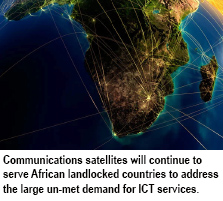The African Satellite Market
 by Peter I. Galace
by Peter I. Galace
During the past ten years, Africa, the second-largest continent in terms of size and population after Asia, has made great strides in improving its telecommmunications infrastructure through submarine fiber cables landing on both the African Eastern and Western coastlines. Today, there are at least 14 operational, major submarine cables in sub-Saharan Africa, providing about 70 Tbit/s of design capacity and over 5.825 Tbit/s of lit, fully available capacity. This is more than double its international bandwidth of only 3 Tbps mark in December 2014. What’s more, a number of new submarine cables are expected to land later in 2018 and into 2019, with local hubs at Djibouti, Angola and Nigeria, further increasing Africa’s capacity.According to the Africa Telecom Transmission Map published by Hamilton Research the volume of intra-regional traffic backhauled to submarine cables increased to 248 Gbps in December 2016, a 65% growth compared to 150 Gbps in 2015. The continued expansion of terrestrial transmission networks is bringing additional countries, regions, cities and towns within reach of fiber networks for the first time. It added that in June 2017 the amount of operational fiber optic network reached 820,397-km, compared to 412,729-km in2012. In June 2017, 52.1% of the population in Sub-Saharan Africa (522 million) was within a 25-km range of an operational fiber optic network node.
But while coastal countries of Africa like South Africa, Kenya, and Namibia are benefitting largely from the ongoing deployment of more submarine fibers, existing communication infrastructure in African hinterlands remains grossly inadequate. ITU sees the need to develop national, regional and sub-regional carrier of carriers and digital links with cross-border inter-connectivity, which satellites can easily provide. Out of Africa’s 55 countries, 16 of them, such as Botswana, Burkina Faso, Burundi, Central African Republic, Chad, and Ethiopia, are landlocked, posing a big challenge in connecting them to the world. Thus, there will continue to be a big demand for a robust infrastructure built in and around African landlocked countries to address the large un-met demand for ICT services that could be brought via communications satellites.
The efforts aimed at increasing the use of ICTs and developing broadband penetration are crucial to augmenting Africa’s economic productivity and GDP growth. In March 2013, Africa was identified as the world’s poorest inhabited continent: Africa’s entire combined GDP is barely a third of the United States’ GDP. However, the World Bank expects that most African countries will reach “middle income” status (defined as at least US$1,000 per person a year) by 2025 if current growth rates continue. World Bank forecasts economic growth in Sub-Saharan Africa to recover steadily and is forecasted to pick up to 3.1% in 2018 and to firm to an average of 3.6% in 2019–20, due largely to the anticipated recovery in the oil sector and continued challenges in the non-oil industrial sectors, especially in Nigeria.
Positive Outlook for Africa
Even as Africa’s telecom infrastructures are growing, it’s connectivity to the world remains grim, but this also means plenty of room for growth.
Today, Africa only has 35.2% Internet penetration, or roughly 453 million of its 1.25 billion on the Internet; or roughly 797 million without Internet. Mobile adoption in the region has grown rapidly in recent years. Overall subscriber penetration reached 44% in 2017, up from just 25% at the start of this decade, but still way below the global average of 66%. According to gsma.com, the subscriber base in the region totaled 444 million, equivalent to around 9% of subscribers globally. The regional subscriber base will grow at a CAGR of 4.8% for the period 2017-2022, more than the global growth rate over the same period.
Africa and the Middle East (AME) pay-TV household penetration is expected to outpace all other major regions between 2017 and 2022, increasing from 16% in 2017 to 23.2% in 2022, says GlobalData, a data and analytics company. According to its report: ‘Pay-TV Market Trends and Opportunities in Africa & the Middle East’, the AME’s pay-TV market is relatively underdeveloped but is growing rapidly and its pay-TV penetration in 2017 fell substantially below the global average of 54.4%.
Because of these trends, there is indeed a large potential for growth. Baker McKenzie’s Global Transaction Forecast, developed in association with Oxford Economics, mergers and acquisitions in the tech and telecoms sector in Africa and the Middle East was valued at US$1.2 billion in 2017. This is predicted to increase to US$5.9 billion in 2018 and a further US$5.9 billion in 2019, before decreasing to US$3.9 billion in 2020.
The report says a more positive global economic outlook, the expansion of technology across industries, investment from emerging markets, and strong corporate balance sheets are the key factors in driving investment in tech M&A around the world, including in Africa.
“Africa’s growing telecoms infrastructure and access to online services and platforms continue to improve access to the online economy. Increased local demand for innovative products, services and solutions drives offshore telecommunications and technology companies to target opportunities in Africa,” says Darryl Bernstein, head of the Technology, Media and Telecommunications (TMT) Practice at Baker McKenzie in Johannesburg, South Africa.
“The growing financial services sector has also seen domestic banks make significant investments in technology to advance their innovation agenda. African tech companies are also targeting offshore investments in companies that will deepen their access to new technologies, markets and talent,” he explains.
Fueling Africa’s growth is the continued surge in commodity prices, promising great returns for Africa’s oil producing nations, such as Nigeria, Angola, Algeria, Egypt and Libya. The recovery of the oil industry in the third quarter of 2018, as well as continued diversity and geographical expansions in oil and gas, banking, mining and government networks will, therefore, continue. Africa’s long-term growth is seemingly assured as reflected in interrelated social and demographic changes that create new domestic engines of growth. Key among these are increasing urbanization, an expanding labor force, and the rise of the middle-class African consumer, which all require improved infrastructure services from all fronts. No wonder, demand for better telecom services continues to rise rapidly.
Thus, mobile and satellite traffic will continue to soar, requiring even more bandwidth. Future growth could also be attributed to the transition to digital TV, which has barely begun in some countries. New enterprise hot spots are evolving, particularly in East and West Africa, in addition to historically strong VSAT markets like South Africa, Nigeria, Angola, Kenya and Tanzania.
All these developments will also mean High throughput satellites (HTS) that offer better broadband access for consumers and enterprises, and provide trunking opportunities for landlocked countries where fiber is limited and unreliable.
But the challenge is not solely in connecting large portions of the African population. Getting infrastructure to parts of Africa is a daunting physical challenge because of the wide differences in geographical terrain. Also, Africa’s 634 million people are without electricity, the majority of whom live in sub-Saharan Africa, and literacy rate is only pegged at around 64.3%, meaning more than 1 in 3 adults cannot read. Then, there is the regulatory hurdle to contend with.
Satellite Operators Expanding in Africa
“Africa is still a growing market. We see opportunites in cellular backhaul, mobility and even in broadcasting services,” said Jacob Jeret, Senior VP of Amos Spacecom. Spacecom will be launching AMOS 17 in early 2019. It will be a state-of-the-art multi-band high-throughput satellite, utilizing Boeing’s advanced digital processor platform, that will provide reliable and flexible satellite solutions and offer a significant competitive advantage for our customers. It will have a combination of broad regional beams and high throughput spot beams to maximize throughput and spectral efficiency. The combination of the inherent flexibility of the digital platform with the mix of fixed and steerable beams ensures fast response to changing customers’ needs.
Intelsat is operating 24 satellites in Africa with three of the four satellites it launched in the last year cover the continent. Brian Jakins, the satellite operator’s regional VP for Africa, reports in the Intelsat website, that the demand is there with Africa seeing a “huge upsurge” in the telecoms market as a whole over the last few years.
“There are a host of applications and services used in the African market. From a broadband perspective there is a lot of growth from a cell backhaul perspective, where mobile networks are trying to offload a load of traffic from their network to maintain their voice services, putting data on a separate route. That’s one of the biggest areas we see in the African market.
“Consumer broadband is also growing significantly, and then trunking. Obviously, that is declining with the advent of undersea cables, but you still have your traditional voice telephony in remote locations and then you also have corporate networks. It is a tried and tested method in remote locations,” Jakin says.
In September this year, Intelsat and Azercosmos, the national satellite operator of Azerbaijan, successfully launched Intelsat 38 and Azerspace-2 satellite aboard an Ariane 5 launch vehicle from the Guiana Space Center in Kourou, French Guiana.
Intelsat 38 is a Ku-band satellite to be placed at the 45ºE orbital location and will replace Intelsat 12 and host Direct-to-Home (DTH) platforms for Central and Eastern Europe as well as the Asia-Pacific region. Intelsat 38 will also provide connectivity for corporate networks and government applications in Africa. It will provide fast, resilient and redundant broadband. Intelsat 38 and Azercosmos-2 are expected to enter into service in the first quarter of 2019.
Azerspace-2 will help Azercosmos meet the growing demand for DTH television, government, and network services in Europe, Central and South Asia, the Middle East and Sub-Saharan Africa. The satellite will also provide high power Ku-band connectivity to the African continent from 45 degrees East. Azerspace-2 is ideally designed for smaller antennas and will deliver cross connectivity between East Africa, West Africa and Central Africa, Europe and Central Asia.
Again in October this year, Intelsat launched Q-KON, a multiple high-speed broadband services to rapidly deploy high-quality broadband that enables new services and applications for smaller businesses throughout Botswana, Mozambique, Namibia, South Africa, Zambia and Zimbabwe.
Q-KON’s offering will incorporate services from Intelsat 33e, one of Intelsat’s next generation high-throughput satellites, and utilize IntelsatOne Flex for Enterprise, a managed wholesale service that removes the complexities and improves the economics of network expansion.
Another leading satellite operator, SES, says it provides coverage over Africa via more than 10 GEO satellites and the entire O3b fleet of MEO satellites. The company has offices in Johannesburg, Accra, Lagos and Addis Ababa, and provides local teams on the ground provide satellite communications solutions to internet service providers, mobile and fixed network operators, businesses and governments across the continent.
On March 9 this year, SES successfully launched four new O3b Medium Earth Orbit (MEO) satellites from the Guiana Space Centre in Kourou, French Guiana. The new Ka-band satellites join the existing O3b constellation of 12 satellites to offer the world’s only low latency, fiber-like connectivity to people and businesses in the growing mobility, fixed data and government markets.
Positioned at approximately 8,000 km, the O3b satellites are approximately ¼ of the distance from the earth than traditional geostationary (GEO) satellites. The lower altitude greatly reduces latency, decreases response times, improves voice and video quality as well as enables an array of cloud services.
With those four new satellites, SES Networks will continue to help bridge the digital divide by providing access to mobile broadband to underserved areas, and help mobile operators address the increasing demand for bandwidth as the number of 4G/LTE subscribers is set to jump from 1.6 billion in 2016 to 3.8 billion by end 2020.
Not to be outdone, Eutelsat also launched its Konnect Africa broadband service in June last year starting in Benin, Cameroon, Kenya, Lesotho, Nigeria, South Africa, Swaziland, Tanzania and Uganda.
Konnect Africa’s innovative service offerings and products, including packaged offers inspired by ‘pay as you go’ models and Wi-Fi hotspot schemes, are fully aligned with the needs and preferences of end-users in these different markets. First partners include local operators, telecom companies and resellers, notabl
AfrikaNet GoSat (Cameroon, Côte d’Ivoire), Bentley Walker (multiple African markets), Bloosat (Cameroon, Central Africa), Coollink (Nigeria), Global Broadband Solution (Democratic Republic of Congo), Terrace Projects (South Africa), Ubora Systems (Kenya), as well as China Telecom that is establishing communications links between the African continent and the Asia-Pacific region. These partners will benefit from dedicated commercial, marketing and technical support from Konnect Africa and training aimed at enhancing service quality.
Konnect Africa is initially using capacity on Yahsat’s Al Yah 2 satellite (16 Ka-band spotbeams) with expansion supported by a further 18 spotbeams on the Al Yah 3 satellite that is scheduled for launch by the end of 2017. Konnect Africa aims to cover most of Sub-Saharan Africa by 2019.
Laurent Grimaldi, CEO of Konnect Africa, said “Connecting Africa means changing the way people live, study, perform business, and transforming daily life. We aim to take broadband further and closer to multiple development sectors such as the healthcare system, education, agriculture or SMEs.”
Eutelsat already has a multi-year agreement with Yahsat, the Abu Dhabi-based international satellite operator, to provide high-performance commercial Ka-band capacity for broadband services across Sub-Saharan Africa.
According to the terms of the agreement Broadband for Africa will use capacity on up to 16 Ka-band spotbeams on the Yahsat 1B satellite in order to roll out broadband services during the first half of 2017. Further expansion will be supported later in the year using capacity on 18 spotbeams on Yahsat’s Al Yah 3 satellite, scheduled for launch in early 2017. Both Yahsat 1B and Al Yah 3 are equipped with high power spotbeams with Sub-Saharan African coverage, ideal for community and Direct-to-User Internet access using affordable, off-the-shelf customer premises equipment.
4G/5G Deployment
4G deployment in Africa is still at a very early stage, at only less than 10% of population. As at 1Q17, 84 of Africa’s 217 mobile operators ran a 4G-LTE network, according to research firm Ovum, and the coverage was limited to selected urban areas. By end-2016, Africa had 14 million LTE subscriptions, which accounted for 1.4% of Africa’s mobile market. South African operators combine 58% of the continent’s LTE subscriptions with LTE network from market leader Vodacom covering 70% the country’s population by end-2016. In the fixed segment, Africa had 2 million LTE subscriptions representing 13% of broadband connections. Ovum says LTE remains a high-end technology that is pushed, with broadband access as the main growth driver. In comparison, the global mobile share of LTE subscriptions was 25% by end-2016.
Ovum adds that slow regulatory processes are delaying technology transition in Africa. The deployment of 5G will, in a great part, depend on spectrum availability in Africa. Lengthy regulatory processes have delayed 3G and 4G launches in Africa. 5G looks very likely to face the same fate as 4G, for which suitable spectrum is still yet to be auctioned in Africa. Southern Africa is expected to lead the 5G race. South Africa, Namibia, and Mauritius are expected take the lead, favored by proactive operators and vendors, as well as a larger high-end addressable market.
Based on the early-2017 African telecoms landscape, Ovum forecasts 5G to make its debut on the continent around 2022, with launches essentially concentrated in North and Southern Africa. The potential early adopters will include early new technology adopters who have pioneered 4G in the region. In Southern Africa, these early adopters are operators such as Vodacom, Telkom, and MTN in South Africa, MTC in Namibia, or Orange and Emtel in Mauritius. Northern African countries such as Morocco or Tunisia, which have higher broadband penetration rates than the continent’s average, also have the potential to be on the list of early 5G adopters, adds Ovum. However, lengthy regulatory processes could hamper operators’ projects. Kenya’s Safaricom is forecast to lead the race in East Africa.
-------------------
 Peter I. Galace is the Associate Editor of Satellite Markets and Research. He writes extensively on telecommunications and satellite developments in Asia and other regions for numerous publications and research firms. He can be reached at peter@satellitemarkets.com.
Peter I. Galace is the Associate Editor of Satellite Markets and Research. He writes extensively on telecommunications and satellite developments in Asia and other regions for numerous publications and research firms. He can be reached at peter@satellitemarkets.com.






